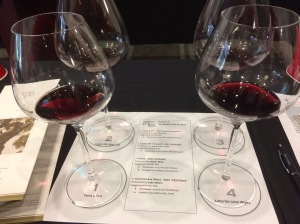“Brave are we who are planting the old vines of tomorrow.” -Jonathan Lachs
 It was said tongue in cheek, but this is exactly what Jonathan Lachs and other Zinfandel growers are doing. Owner and winemaker of Cedarville Vineyards along with Susan Marks, Jonathan has been planting his future old vines since the winery was founded in 1997. The winery and vineyards are located in Fair Play in El Dorado County at an elevation of 2500 feet. It is that elevation that gives the Cedarville Zinfandel its structure and acidity. It is the age of the vines that gives the wine its rich, intense flavor.
It was said tongue in cheek, but this is exactly what Jonathan Lachs and other Zinfandel growers are doing. Owner and winemaker of Cedarville Vineyards along with Susan Marks, Jonathan has been planting his future old vines since the winery was founded in 1997. The winery and vineyards are located in Fair Play in El Dorado County at an elevation of 2500 feet. It is that elevation that gives the Cedarville Zinfandel its structure and acidity. It is the age of the vines that gives the wine its rich, intense flavor.
The Cedarville 2015 Zinfandel has aromas of rich red and black fruit with notes of pepper and spice. It is well structured and elegant, not an ‘in-your-face’ Zin, but a graceful, interesting Zin, one that could age.
Zinfandel is considered one of ‘America’s grapes,’ even though it is from the vitus vinifera species, the European species of grapes. In other countries, however, Zinfandel is not embraced as a single varietal the way it is here in the U.S. America has embraced Zinfandel, (known as Crljenak Kastelanski in Croatia, its country of origin, and called Primitivo in Italy where it is also grown) as its own. However, for most of their American history, these grapes have not been treated as great or noble grapes. There are a number of winemakers who would like to change that.
According to Jake Bilbro, owner and winemaker of Limerick Lane Wines in Healdsburg in Sonoma County, there are four misconceptions about Zinfandel that are holding back the wine’s reputation. Misconception number one is that all Zinfandels have residual sugar. The more elegant Zins will be fermented dry. ‘Zinfandel only pairs with Barbeque’ is the second misconception. More and more winemakers are making elegant, structured wines that will pair well with lots of dishes. And not all Zinfandels are necessarily fruit-forward and lacking structure. These are misconceptions numbers three and four. Many Zinfandel vineyards are grown in warm climates, but more and more winemakers are growing Zin in vineyards that are at high altitude or in cooler climates. This is what will give the wine its structure and subdue its fruit-forwardness.
The 1910 Block Zinfandel from Limerick Lane is made from grapes from a vineyard planted in 1910. The vineyard is located in the northeast corner of the Russian River Valley. The wine has the intensity of old vine fruit, blackberry, and spice with a lean acidity from the cool nights of the region. Its elegance bucks all the misconceptions that Jake Bilbro has set out to overcome.
Zinfandel has been grown in the United States for over 150 years. It has truly become America’s grape. And as America’s wine tastes have become more sophisticated and elegant, so has America’s Zinfandel.
 Founded in 1869 as a train stop for the Central Pacific Railroad, Lodi began as a farming community known for wheat and watermelons. Lodi was also known, early on for grapes. Since the 19th century Lodi has moved from the Tokay grape to the Zinfandel grape. Home to over 80 wineries and a downtown bursting with fine restaurants, Lodi presents itself with the sophistication of a city in the charm of a small town. At its heart, Lodi is still a farming community.
Founded in 1869 as a train stop for the Central Pacific Railroad, Lodi began as a farming community known for wheat and watermelons. Lodi was also known, early on for grapes. Since the 19th century Lodi has moved from the Tokay grape to the Zinfandel grape. Home to over 80 wineries and a downtown bursting with fine restaurants, Lodi presents itself with the sophistication of a city in the charm of a small town. At its heart, Lodi is still a farming community. Chuck Spenker is a 3rd generation grower and Lodi farmer. His farm, Spenker Winery is located just west of downtown Lodi where he grows Petite Sirah, Muscat and Zinfandel. Dinner at Spenker Winery with the Spenker family includes not only their wines but their farm-made goat cheese, which was fresh and creamy and all the more tasty having met the goats before dinner. Every goat is named, and every name fit, especially Shenanigans a mischievous character indeed.
Chuck Spenker is a 3rd generation grower and Lodi farmer. His farm, Spenker Winery is located just west of downtown Lodi where he grows Petite Sirah, Muscat and Zinfandel. Dinner at Spenker Winery with the Spenker family includes not only their wines but their farm-made goat cheese, which was fresh and creamy and all the more tasty having met the goats before dinner. Every goat is named, and every name fit, especially Shenanigans a mischievous character indeed. 
